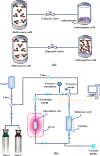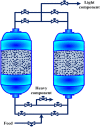Carbon dioxide separation and capture by adsorption: a review
- PMID: 37362013
- PMCID: PMC10018639
- DOI: 10.1007/s10311-023-01589-z
Carbon dioxide separation and capture by adsorption: a review
Abstract
Rising adverse impact of climate change caused by anthropogenic activities is calling for advanced methods to reduce carbon dioxide emissions. Here, we review adsorption technologies for carbon dioxide capture with focus on materials, techniques, and processes, additive manufacturing, direct air capture, machine learning, life cycle assessment, commercialization and scale-up.
Keywords: Adsorption technology; Biogas upgrading; Carbon dioxide capture; Climate change mitigation; Sustainability.
© The Author(s), under exclusive licence to Springer Nature Switzerland AG 2023, Springer Nature or its licensor (e.g. a society or other partner) holds exclusive rights to this article under a publishing agreement with the author(s) or other rightsholder(s); author self-archiving of the accepted manuscript version of this article is solely governed by the terms of such publishing agreement and applicable law.
Conflict of interest statement
Conflict of interestAuthors declare no competing financial interest.
Figures















References
-
- AbdulKareem FA, Shariff AM, Ullah S, et al. Adsorption performance of 5A molecular sieve zeolite in water vapor–binary gas environment: experimental and modeling evaluation. J Ind Eng Chem. 2018;64:173–187. doi: 10.1016/J.JIEC.2018.03.014. - DOI
-
- AGGI (2022) Climate change: annual greenhouse gas index, https://www.climate.gov/news-features/understanding-climate/climate-chan...
-
- Aghel B, Behaein S, Wongwises S, Shadloo MS. A review of recent progress in biogas upgrading: with emphasis on carbon capture. Biomass Bioenergy. 2022;160:106422. doi: 10.1016/J.BIOMBIOE.2022.106422. - DOI
-
- Ahmed SF, Mofijur M, Tarannum K, et al. Biogas upgrading, economy and utilization: a review. Environ Chem Lett. 2021;19(6):4137–4164. doi: 10.1007/S10311-021-01292-X. - DOI
Publication types
LinkOut - more resources
Full Text Sources
